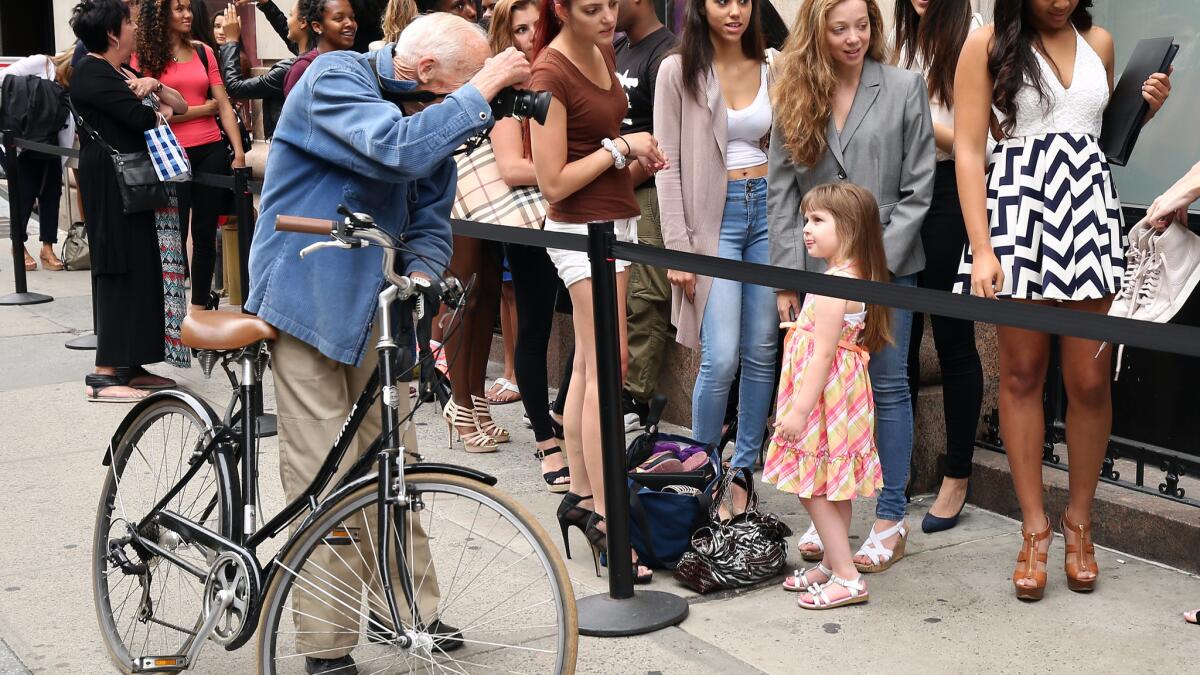From the Archives: Movie review: ‘Bill Cunningham New York’

Obsessive artists often create exceptional bodies of work. Think of Simon Rodia constructing Watts Tower or Eugene Atget photographing the buildings of Paris. Neither of these men considered themselves artists, and neither does Bill Cunningham. But based on the charming documentary “Bill Cunningham New York,” he deserves to be on the list.
A genial fanatic who completely lives for his work, the eightysomething Cunningham can invariably be found doing what he’s done for half a century: pedaling around Manhattan on his bicycle with the energy of a man half his age, searching the streets for fashion trends.
“I let the street speak to me; you have to stay on the street and let the street tell you,” is how the man puts it. “There are no shortcuts, believe me.”
Single-handedly responsible for the visuals in two weekly New York Times photo columns, “On the Street” and the more society-oriented “Evening Hours,” Cunningham says he uses his camera “like a pen. I use it to take notes.”
The photographer’s monastic devotion to his calling is legendary.
So unstoppable in pursuit of his vision that he’s been compared to a war photographer (“he’ll do anything for the shot,” a colleague says), Cunningham is relentless in teasing out trends, a visual poet of street-style presentation who cares intensely about fashion and beauty and has a purist’s disdain for celebrity.
Because Cunningham is an intensely private individual, director Richard Press says that of the 10 years it took to make this admiring labor of love, eight were spent convincing the reluctant subject to participate.
Cunningham’s reticence meant that Press worked with no crew and used small, hand-held consumer cameras for the shoot, shadowing the photographer as he piloted his 29th Schwinn bicycle (the first 28 were all stolen) around Manhattan’s mean streets in search of beauty.
The photographer’s monastic devotion to his calling is legendary. He lived for decades in a tiny studio apartment above Carnegie Hall, filled almost exclusively with the file cabinets that hold his negatives. He always wears the same clothes — inexpensive ponchos he continually repairs and blue jackets worn by French street sweepers. He has no interest in eating, sleeping or anything else, and even the possibility of being evicted doesn’t faze him: “You can’t interrupt your life for that nonsense” is his response to that threat.
Because Cunningham’s interest is so undeniably pure, and because he doesn’t believe in mocking or unkind photographs, he has legions of devoted readers, including society types such as Annette de la Renta, who likely wouldn’t appear on-screen for anyone else. Also a fan is Vogue editor Anna Wintour, who has famously said, “We all get dressed for Bill.”
Also making appearances are many of Cunningham’s most eccentric subjects, far-out dressers such as Patrick McDonald, Iris Apfel and Shail Upadhya, a former U.N. official from Nepal whose eccentric style earned him the title of “the designing diplomat.”
Front and center in all of this, though he clearly would rather not be, is Cunningham himself, a man of enormous good cheer who gets riled only when he fears his creative prerogatives are being infringed upon.
Working with producer Philip Gefter and cinematographer Tony Cenicola, both former New York Times colleagues of Cunningham’s, Press has gotten the photographer to talk about aspects of his private life that the man himself is probably surprised he revealed.
A regular churchgoer, Cunningham also has an almost religious regard for fashion, which he calls “the armor to survive the reality of everyday life.” To do away with it, he says, “would be like doing away with civilization.” That is devotion for sure.
More to Read
Only good movies
Get the Indie Focus newsletter, Mark Olsen's weekly guide to the world of cinema.
You may occasionally receive promotional content from the Los Angeles Times.










